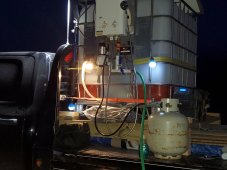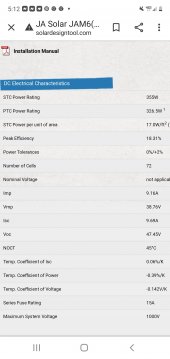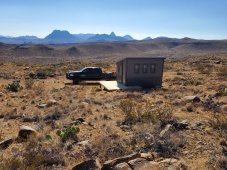You are using an out of date browser. It may not display this or other websites correctly.
You should upgrade or use an alternative browser.
You should upgrade or use an alternative browser.
Newbie Here
- Thread starter Snubber
- Start date
FilterGuy
Solar Engineering Consultant - EG4 and Consumers
Welcome!!! Ask lots of questions!!!
Snubber
New Member
- Joined
- Aug 27, 2021
- Messages
- 42
I'm working on that. I have a shed in the desert ( southwest Texas ). It's only 8' X 12'. I picked up ( 3 ) 355W Poly Panels that will fit on the roof. They were $100 ea. and I couldn't resist. I'd just like to run a small a/c ( possibly 8 hrs ) and a small TV at night ( 4 - 6 hrs ). I haven't figured all that out yet but I'll need suggestions when I do. I don't even know if that's going to be enough PV.OK, an "Off Grid Solar Shower" is a start.
Now for PV, you need to make a list of your electrical needs, including type of load, peak watts, and watt-hours per day.
Snubber
New Member
- Joined
- Aug 27, 2021
- Messages
- 42
ThanksWelcome!!! Ask lots of questions!!!
MisterSandals
Participation Medalist
Some panasonic window A/C units are about 600WI'd just like to run a small a/c ( possibly 8 hrs )
600W x 8h = 4800Wh
Solar:
3x 355W x 5h solar (average) = 5325Wh
You'd be fortunate to get this to work. Add your numbers for your TV and other things to get a feel for how much solar you need. If you determine how much of this needs to run after prime solar hours, that will be the needed battery capacity for each day after solar charging.
Snubber
New Member
- Joined
- Aug 27, 2021
- Messages
- 42
There's water for sale about 12 miles away. I have a 110 gallon tank on my truck. My shower is a propane tankless heater fed by a 50 gpm 12v pump. 12v battery with a 100w panel. I love my place , but it gets HOT in the summer. Going in October to insulate it.How do you get water?
Attachments
Hedges
I See Electromagnetic Fields!
- Joined
- Mar 28, 2020
- Messages
- 21,047
I am definitely going to need a significant battery bank.
Battery is the most expensive part of an off-grid system. Also the shortest lived, unless electronics turns out to be poor quality.
To me, the thing to do is try to minimize battery.
That can mean putting in excess PV (sometimes letting production go to waste), and using power when produced as much as possible rather than saving for later. PV costs less than batteries and lasts longer.
Also, cycling battery heavier and wearing it out sooner (I'd rather pay 1/4 as much for a battery and wear it out in 2.5 years rather than 10 years, get my money's worth sooner. That probably only applies to lead-acid, because lithium ought to last a decade of 80% cycling. So I wouldn't want to buy oversize lithium bank and cycle it less than 80%)
The question becomes, "What are the loads that must be operated when sun isn't out?"
You then need a system which regulated battery charging current to an acceptably low level, while delivering all available power to inverter. There are several ways this can be accomplished. Hybrids with SCC and inverter built in are one. Some SCC like from Victron can be controlled based on a battery shunt. AC coupled systems have a separate battery inverter.
Snubber
New Member
- Joined
- Aug 27, 2021
- Messages
- 42
Where I'm located , believe it or not , it cools down pretty quick after sunset and the humidity is really low. I'm thinking the a/c would be turned off at this time. Draw on the bank would just be a TV , led light and a small 12v fan. I would say it's sunny 300 days a year. There is a fella in that area that building lithium batteries. What's the general feeling about those?Battery is the most expensive part of an off-grid system. Also the shortest lived, unless electronics turns out to be poor quality.
To me, the thing to do is try to minimize battery.
That can mean putting in excess PV (sometimes letting production go to waste), and using power when produced as much as possible rather than saving for later. PV costs less than batteries and lasts longer.
Also, cycling battery heavier and wearing it out sooner (I'd rather pay 1/4 as much for a battery and wear it out in 2.5 years rather than 10 years, get my money's worth sooner. That probably only applies to lead-acid, because lithium ought to last a decade of 80% cycling. So I wouldn't want to buy oversize lithium bank and cycle it less than 80%)
The question becomes, "What are the loads that must be operated when sun isn't out?"
You then need a system which regulated battery charging current to an acceptably low level, while delivering all available power to inverter. There are several ways this can be accomplished. Hybrids with SCC and inverter built in are one. Some SCC like from Victron can be controlled based on a battery shunt. AC coupled systems have a separate battery inverter.
Hedges
I See Electromagnetic Fields!
- Joined
- Mar 28, 2020
- Messages
- 21,047
Lithium batteries cost something of a premium if purchased ready-made. Could be 2x to 10x what lead-acid costs. Cycle life could be 5x to 10x.
If you buy 280 Ah LiFePO4 cells and BMS, and go through the project of DIY, should cost maybe 40% what AGM costs and something less than FLA.
Lithium may or may not last the expected number of cycles. With DIY you probably come out ahead if it lasts just 20% of what you hoped for.
Issues with lithium:
1) Current draw limited by BMS (or external contactor.)
2) They can catch fire. Put them in a bunker away from you and the home.
3) can't be charged below freezing. While they accept about 0.5C charge rate at room temperature, that declines to about 0.1C near freezing.
I think Lithium can be used in a system which regulates charging to about 0.1C or 0.15C, with low-temperature cutout by BMS set for a temperature where that charge current is acceptable.
PV array can be much larger and will maintain that charge rate all day long so always gets recharged by night. With moderate overcast it still gets recharged.
You just need a system which regulates battery charge current while delivering much more when used by inverter.
My AGM battery receives 0.2C charge rate, although PV could deliver closer to 1.0C. This lets me run A/C and whatever loads I want. I have an AC coupled SMA system.
For a small system, one of the hybrids could be most economical. Should be able to program max charge rate.
You need to select something with an inverter capable of delivering starting surge current for your motor loads - typically 5x nameplate power draw.
If you buy 280 Ah LiFePO4 cells and BMS, and go through the project of DIY, should cost maybe 40% what AGM costs and something less than FLA.
Lithium may or may not last the expected number of cycles. With DIY you probably come out ahead if it lasts just 20% of what you hoped for.
Issues with lithium:
1) Current draw limited by BMS (or external contactor.)
2) They can catch fire. Put them in a bunker away from you and the home.
3) can't be charged below freezing. While they accept about 0.5C charge rate at room temperature, that declines to about 0.1C near freezing.
I think Lithium can be used in a system which regulates charging to about 0.1C or 0.15C, with low-temperature cutout by BMS set for a temperature where that charge current is acceptable.
PV array can be much larger and will maintain that charge rate all day long so always gets recharged by night. With moderate overcast it still gets recharged.
You just need a system which regulates battery charge current while delivering much more when used by inverter.
My AGM battery receives 0.2C charge rate, although PV could deliver closer to 1.0C. This lets me run A/C and whatever loads I want. I have an AC coupled SMA system.
For a small system, one of the hybrids could be most economical. Should be able to program max charge rate.
You need to select something with an inverter capable of delivering starting surge current for your motor loads - typically 5x nameplate power draw.
Snubber
New Member
- Joined
- Aug 27, 2021
- Messages
- 42
The a/c I'm looking at is 600 watt ( not sure of surge. 1000? ). My panels are 355w x3 for roughly 1000watts ( see attached spec sheet ) wired in series. So this would require a min. 60 amp SCC for a 24 v system? I'm thinking 60 amp / 150v mppt SCC , 2000w pure sine wave inverter and a 24 - 12 step down for my 12v stuff.
280ah lithium ion bank?
280ah lithium ion bank?
Attachments
Hedges
I See Electromagnetic Fields!
- Joined
- Mar 28, 2020
- Messages
- 21,047
Assume 5x surge for a second, so 3kW for seconds not 10's of milliseconds from the inverter.
A good 2000W inverter with real surge capability could do it. Not a lightweight one.
Lithium has its advantages. Depending on how low your night time draw, you might get away with cheap lead-acid. Figure out watt-hours needed.
I measured an A/C just as bit smaller.

 diysolarforum.com
diysolarforum.com
Anything you can do to reduce heat load, shading all faces of the shed that receive sun, will help let the A/C keep it cool.
As for PV, I'd think 3x what you've got, with multiple orientations.
A good 2000W inverter with real surge capability could do it. Not a lightweight one.
Lithium has its advantages. Depending on how low your night time draw, you might get away with cheap lead-acid. Figure out watt-hours needed.
I measured an A/C just as bit smaller.

Is 600w enough
I plan on putting 600w of solar panels on the roof of a small camper. The Panels will be able to tilt so I can get as much power as I can. My main use is to run a 5000 BTU AC tha draws 450w in the summer and a 500w space heater in the winter & a few little items like phones, tablets and led...
Anything you can do to reduce heat load, shading all faces of the shed that receive sun, will help let the A/C keep it cool.
As for PV, I'd think 3x what you've got, with multiple orientations.
Snubber
New Member
- Joined
- Aug 27, 2021
- Messages
- 42
Well , I'm kinda short on shade. ?Assume 5x surge for a second, so 3kW for seconds not 10's of milliseconds from the inverter.
A good 2000W inverter with real surge capability could do it. Not a lightweight one.
Lithium has its advantages. Depending on how low your night time draw, you might get away with cheap lead-acid. Figure out watt-hours needed.
I measured an A/C just as bit smaller.

Is 600w enough
I plan on putting 600w of solar panels on the roof of a small camper. The Panels will be able to tilt so I can get as much power as I can. My main use is to run a 5000 BTU AC tha draws 450w in the summer and a 500w space heater in the winter & a few little items like phones, tablets and led...diysolarforum.com
Anything you can do to reduce heat load, shading all faces of the shed that receive sun, will help let the A/C keep it cool.
As for PV, I'd think 3x what you've got, with multiple orientations.
But I do plan to foam the heck out of it. ( yes , the roof is slanted south )
Attachments
Similar threads
- Replies
- 5
- Views
- 194
- Replies
- 4
- Views
- 326
- Replies
- 3
- Views
- 209







